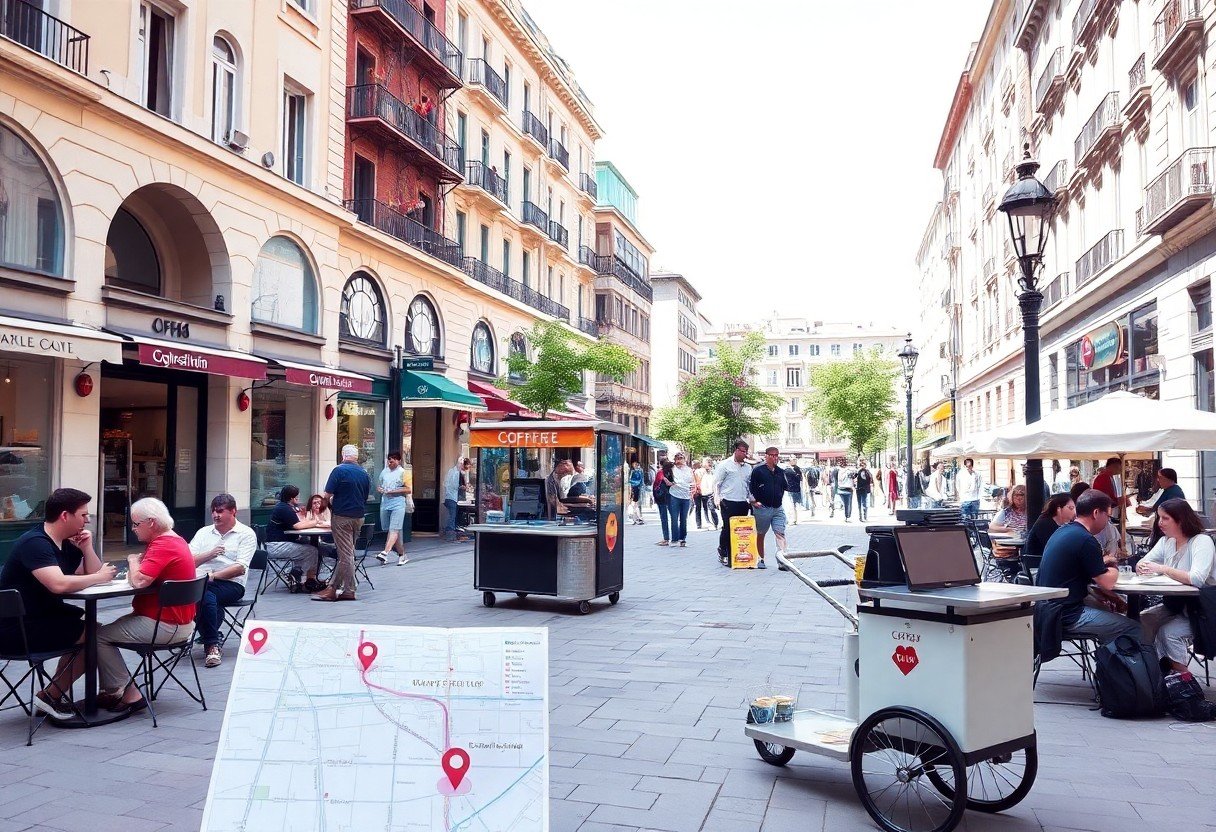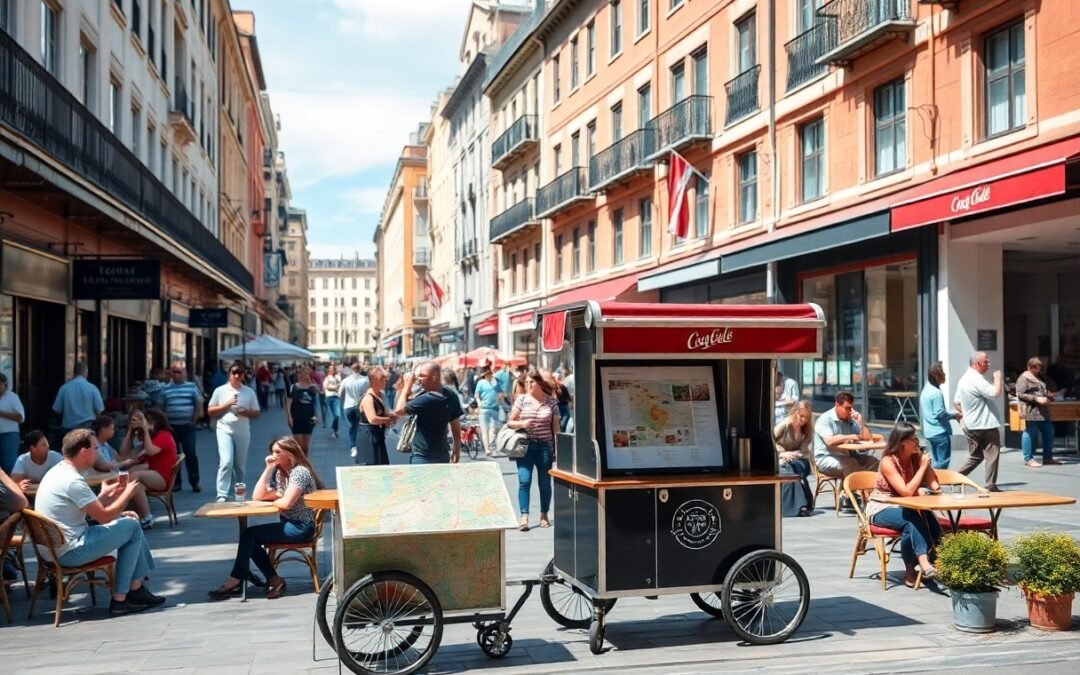Coffee thrives in the right environment, making location a vital factor for your mobile coffee cart or van’s success. You need to strategically choose spots that attract foot traffic and cater to your target audience. This guide will walk you through necessary considerations and tips to help you identify the most effective locations that enhance visibility and customer engagement, ensuring that your coffee business flourishes.
Decoding Your Target Market
Understanding your target market lays the groundwork for selecting an ideal location for your mobile coffee cart or van. Tailoring your offerings to the preferences and habits of potential customers can significantly enhance profitability and ensure a loyal customer base. This means looking beyond just foot traffic and considering who frequents various hotspots, what their coffee consumption habits are, and how to cater to their tastes effectively.
Identifying Your Ideal Customer
Defining your ideal customer involves considering demographic factors such as age, income level, and lifestyle preferences. For instance, targeting college students may require affordable pricing and a trendy menu, while corporate professionals might appreciate premium blends and quick service. Creating customer personas can help you visualize who you’re serving, making it easier to adjust your offerings and marketing strategies to better engage with these groups.
Analyzing Local Consumer Behavior
Consumer behavior in your area informs where you should park your mobile coffee cart or van. Researching local trends, such as peak consumption times and popular beverages, can guide your decisions. Additionally, consider seasonal variations; iced coffee may dominate in summer, whereas warm beverages may see increased sales in winter. Engaging with local social media groups or attending community events also provides insights into what customers seek, allowing you to position your cart effectively.
Analyze data from local businesses and online platforms to identify trends in consumer behavior. Core aspects to monitor include peak hours for coffee consumption and menu preferences at nearby cafes. For example, if local cafes see heavy traffic in the mornings and a preference for specialty lattes, positioning your cart nearby during these times could increase your sales significantly. Surveying potential customers and leveraging local market research can deepen your understanding of how shifting tastes and seasonal patterns impact consumer behavior, enabling you to adapt your offerings in real-time.
Navigating Legalities and Permitting
Understanding all local regulations is crucial to successfully operating your mobile coffee cart or van. Each area has its own set of health codes, zoning laws, and restrictions which can vary significantly between cities and counties. Researching these requirements ensures you avoid penalties and maximize your operational potential. Be proactive in checking local government websites or contacting relevant agencies for detailed information on what is specifically required in your area.
Understanding Local Regulations
You must familiarize yourself with specific regulations governing food service in your locality. Health and safety codes, for example, dictate how food and beverages should be prepared and served, necessitating that you keep your equipment compliant with these standards. Additionally, zoning regulations can determine where you can legally operate, so investigate any restrictions based on your chosen area.
Securing Necessary Permits
To legally operate your mobile coffee cart, you must acquire the right permits. This typically includes health permits, business licenses, and possibly parking permits, depending on where you plan to park and serve. Each permit can come with varying fees and approval processes, so it’s wise to create a timeline and checklists based on your local requirements.
Securing necessary permits often involves multiple steps and specific documentation. For instance, health permits usually require inspections to ensure compliance with food safety regulations. Depending on your location, you might also need to submit a detailed business plan and proof of insurance. Take the time to engage with local health departments and business licensing offices, as they can provide tailored guidance and resources. Some regions even mandate acquiring a transient vendor’s license if you operate in public spaces, so investigate those possibilities for compliance and operational success.

Uncovering High-Traffic Locations
Your success largely hinges on finding locations where foot traffic is plentiful and predictable. Areas near offices, schools, parks, and public transit hubs can provide a steady stream of potential customers. Utilize local event calendars and community boards to pinpoint gatherings, markets, or festivals that draw large crowds, amplifying your visibility and sales potential.
Identifying Strategic Hotspots
Focus on areas that align with your target market’s lifestyle. Busy intersections, popular shopping districts, and outside venues for community events are perfect choices. Analyze foot traffic patterns during different times of the day and week to pinpoint where customers congregate consistently, ensuring a higher chance of sales.
Timing Your Operations for Maximum Footfall
Aligning your hours of operation with peak foot traffic can significantly boost your revenue. Early morning hours cater to commuters seeking a caffeine fix, while lunch breaks draw in local workers. Stay operational during events or festivals to capitalize on the influx of visitors eager for refreshments.
A study conducted in urban areas shows that coffee carts positioned near business districts see a 30% increase in sales during morning rush hours, while weekend events can generate up to five times the average daily sales. Monitoring local trends and seasonal events also helps you adjust your schedule for maximum impact. For instance, setting up near a summer concert series can yield high returns as attendees flock to outdoor relaxations. Adapting to these rhythms will enhance your customer reach and overall profitability.
Evaluating Competition Landscape
Analyzing the competition in your chosen area reveals insights about market saturation and potential customer preferences. Understanding who your competitors are, their strengths, and their weaknesses allows you to strategically position your mobile coffee cart or van. This assessment helps you identify gaps in the market and opportunities for innovation, ensuring your offerings stand out while catering to the needs of clients in your vicinity.
Mapping Out Competitors’ Locations
Plotting your competitors on a map helps you visualize their proximity to your intended setup. Identifying clusters of coffee vendors, cafes, and food trucks allows you to select a location that minimizes overlap and optimizes your customer reach. Tools like Google Maps can facilitate this process, enabling you to analyze foot traffic patterns and popular gathering spots effectively.
Differentiating Your Offerings
Offering unique products or services sets you apart from the competition and attracts diverse customer demographics. Focus on high-quality ingredients, specialty drinks, or unique food pairings that reflect local tastes or trends. Consider incorporating seasonal offerings or collaborations with local businesses to build community ties while enhancing your menu.
For instance, if your competitors mainly serve traditional espresso drinks, introducing options like cold brews, nitro coffee, or plant-based alternatives could tap into the growing demand for diverse and health-conscious beverages. Complementing drinks with locally sourced pastries or vegan snacks not only differentiates your cart but also supports other small businesses, enriching the local ecosystem and fostering customer loyalty. Engaging with your audience via social media to showcase these unique offerings can further elevate your brand in a crowded market.
The Power of Partnerships and Collaboration
Partnerships can significantly enhance your mobile coffee venture, creating mutually beneficial relationships that boost sales and customer engagement. Collaborating with local businesses and community events helps build a strong network, expanding your reach and visibility. By aligning with others, you can tap into their customer base, fostering community and loyalty around your brand.
Building Relationships with Local Businesses
Establishing relationships with nearby businesses can lead to valuable referrals and cross-promotions. Approach local cafés, bookstores, or offices to propose collaboration ideas, such as offering discounts to each other’s customers or setting up your mobile unit at their location during peak times. This local synergy amplifies your brand presence and can drive foot traffic to both locations.
Enhancing Visibility through Events
Participating in community events, markets, and festivals can dramatically increase your visibility. These gatherings attract large crowds, offering you the chance to showcase your offerings to new potential customers. Sponsored local events, farmers’ markets, and fairs not only provide foot traffic but also connect you with a community that appreciates supporting small businesses.
Events serve as a platform for engagement, allowing you to interact directly with potential customers. Successful vendors often use these opportunities to promote special menu items, launch limited-time offers, or build brand awareness through unique presentations. For instance, setting up at a local art festival can attract a crowd interested in your product, while offering free samples encourages visitors to stop by and perhaps return later. Engaging with the community at such events fosters not just sales, but relationships that keep customers coming back long after the event has ended.
Summing up
The key to finding the perfect location for your mobile coffee cart or van lies in extensive research and understanding your target audience. You should explore high-traffic areas, consider local events, and assess competition to enhance visibility and customer engagement. Prioritize locations with easy access and adequate parking to ensure convenience for your customers. Utilize social media and community insights to identify popular gathering spots, allowing you to maximize your presence and boost sales. By focusing on these elements, you can position your mobile coffee business for success.
FAQ
Q: What are the key factors to consider when choosing a location for my mobile coffee cart or van?
A: Important factors include foot traffic, proximity to competitors, local events, permits and regulations, and access to utilities like water and electricity.
Q: How can I assess foot traffic in a potential location?
A: Visit the site during different times of the day and week to observe the number of people passing by. Additionally, consider conducting surveys or checking local event calendars for peak times.
Q: Are there specific permits needed to operate my mobile coffee business in certain locations?
A: Yes, you may need vendor permits, health department permits, or local business licenses. Check with your city or county regulations to ensure compliance.
Q: What type of locations are generally more successful for mobile coffee businesses?
A: Successful locations often include busy urban areas, parks, business districts, events and festivals, college campuses, or areas with high foot traffic such as transportation hubs.
Q: How can I adapt my coffee cart or van to different locations effectively?
A: Customize your menu based on the local clientele, consider your hours of operation to align with peak times of the area, and use effective signage to attract attention.

